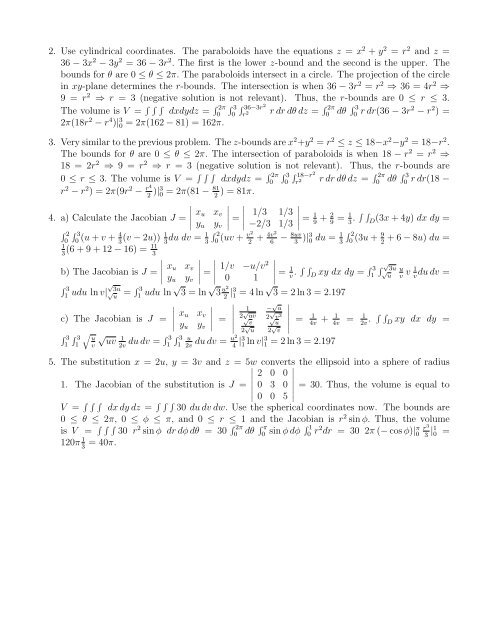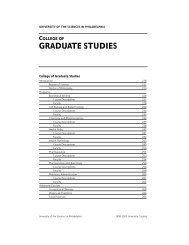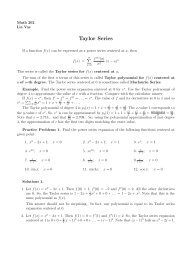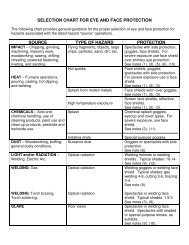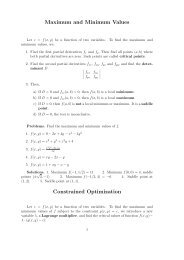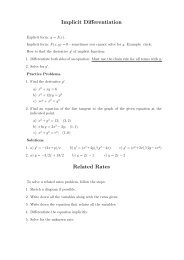Change in Variables; Cylindrical, Spherical Coordinates
Change in Variables; Cylindrical, Spherical Coordinates
Change in Variables; Cylindrical, Spherical Coordinates
- No tags were found...
You also want an ePaper? Increase the reach of your titles
YUMPU automatically turns print PDFs into web optimized ePapers that Google loves.
2. Use cyl<strong>in</strong>drical coord<strong>in</strong>ates. The paraboloids have the equations z = x 2 + y 2 = r 2 and z =36 − 3x 2 − 3y 2 = 36 − 3r 2 . The first is the lower z-bound and the second is the upper. Thebounds for θ are 0 ≤ θ ≤ 2π. The paraboloids <strong>in</strong>tersect <strong>in</strong> a circle. The projection of the circle<strong>in</strong> xy-plane determ<strong>in</strong>es the r-bounds. The <strong>in</strong>tersection is when 36 − 3r 2 = r 2 ⇒ 36 = 4r 2 ⇒9 = r 2 ⇒ r = 3 (negative solution is not relevant). Thus, the r-bounds are 0 ≤ r ≤ 3.The volume is V = ∫ ∫ ∫ dxdydz = ∫ 2π02π(18r 2 − r 4 )| 3 0 = 2π(162 − 81) = 162π.∫ 30∫ 36−3r 2r 2r dr dθ dz = ∫ 2π0 dθ ∫ 30 r dr(36 − 3r2 − r 2 ) =3. Very similar to the previous problem. The z-bounds are x 2 +y 2 = r 2 ≤ z ≤ 18−x 2 −y 2 = 18−r 2 .The bounds for θ are 0 ≤ θ ≤ 2π. The <strong>in</strong>tersection of paraboloids is when 18 − r 2 = r 2 ⇒18 = 2r 2 ⇒ 9 = r 2 ⇒ r = 3 (negative solution is not relevant). Thus, the r-bounds are0 ≤ r ≤ 3. The volume is V = ∫ ∫ ∫ dxdydz = ∫ 2π0r 2 − r 2 ) = 2π(9r 2 − r4 2 )|3 0 = 2π(81 − 81) = 81π.2∣ x4. a) Calculate the Jacobian J = u x ∣∣∣∣ v=∣ y u y v ∣∫ 2 ∫ 30 0 (u + v + 4(v − 2u)) 1du dv = 1 3 3 31(6 + 9 + 12 − 16) = 11 3 3∣ xb) The Jacobian is J = u x ∣∣∣∣ v=∣ y u y v ∣∫ 31 udu ln v|√ √3uu= ∫ 31 udu ln √ 3 = ln √ 3 u2c) The Jacobian is J =∫ 3 ∫ 31 1√ uv√ uv1du dv = ∫ 3 ∫ 32v 1 1∫ 301/3 1/3−2/3 1/3∫ 18−r 2r 2∫ 2 v20 (uv + + 4v2 − 8uv2 6 3 )|3 0 du = 1 31/v −u/v 20 1r dr dθ dz = ∫ 2π0 dθ ∫ 30 r dr(18 −∣ = 1 + 2 = 1. ∫ ∫ 9 9 3 D (3x + 4y) dx dy =∫ 20 (3u + 9 + 6 − 8u) du =2∣ = 1. ∫ ∫ v D xy dx dy = ∫ 312 |3 1 = 4 ln √ 3 = 2 ln 3 = 2.197∣ x u x ∣∣∣∣ 1v=2 √ − √ uuv 2 √ √ √v ∣ y u y 3vv ∣2 √ uu 2 √ ∣vu2vdu dv =u24 |3 1 ln v| 3 1 = 2 ln 3 = 2.197∫ √ 3u√ uuv 1 du dv =v v= 1 + 1 = 1 . ∫ ∫ 4v 4v 2v D xy dx dy =5. The substitution x = 2u, y = 3v and z = 5w converts the ellipsoid <strong>in</strong>to a sphere of radius2 0 01. The Jacobian of the substitution is J =0 3 0= 30. Thus, the volume is equal to∣ 0 0 5 ∣V = ∫ ∫ ∫ dx dy dz = ∫ ∫ ∫ 30 du dv dw. Use the spherical coord<strong>in</strong>ates now. The bounds are0 ≤ θ ≤ 2π, 0 ≤ φ ≤ π, and 0 ≤ r ≤ 1 and the Jacobian is r 2 s<strong>in</strong> φ. Thus, the volumeis V = ∫ ∫ ∫ 30 r 2 s<strong>in</strong> φ dr dφ dθ = 30 ∫ 2π0 dθ ∫ π0 s<strong>in</strong> φ dφ ∫ 10 r2 dr = 30 2π (− cos φ)| π 0 r3 3 |1 0 =120π 1 = 40π.3


